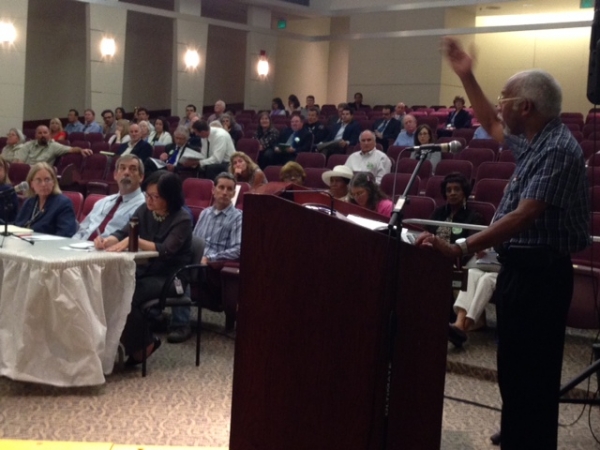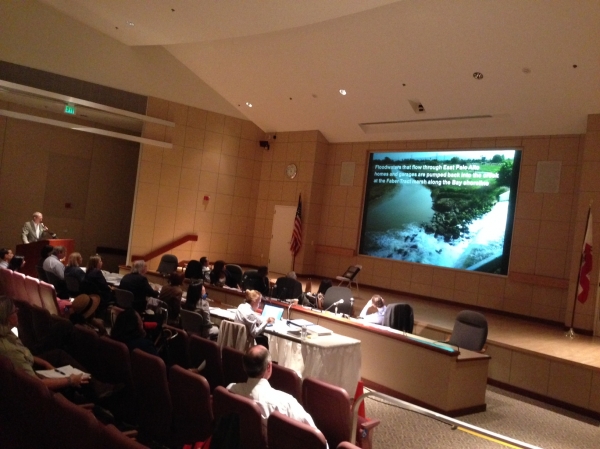It's been more than 16 years since a flood swept through the homes of Spencenia Sims and her neighbors in East Palo Alto, and the day rarely strays far from their minds come winter time.
After the flood in February 1998, Sims's house was one of about 1,700 in East Palo Alto, Palo Alto and Menlo Park to suffer water damage after San Francisquito Creek overflowed in the largest ever recorded spill. She was displaced for three months. In December 2012, a smaller flood forced her out of her home for the night.
Sims was one of more than 60 residents from the three cities who brought their passionate, frustrated and at times angry pleas on Wednesday to a meeting of a state agency that some have blamed for standing in the way of an urgently needed solution. The San Francisquito Creek Joint Powers Authority, which includes elected officials from the three cities and two counties on either side of the creek, has been trying for more than a year to get a permit from the San Francisco Bay Regional Water Quality Control Board so that it can begin widening levees, building flood walls and restoring marshlands as part of the long-planned flood-control effort. In March, staff from the water board rejected the creek authority's permit requests and requested more information and design modifications. The creek authority reapplied on July 31.
During a long and emotional meeting in Oakland, dozens of residents, elected leaders and senior staff from the three cities appealed to the board to approve the project, which aims to protect the particularly flood-prone area in the downstream section of the watershed.
"We are asking you to help us," Sims told the board. "We need your help."
Dennis Parker, who lives in the Gardens neighborhood of East Palo Alto and was one of many attendees to wear "Permit our Project" buttons to Wednesday's meeting, echoed her plea.
"We are here to put a human face on something that might seen like a engineering project or a wildlife project," Parker said. "There are human beings here at risk.
"We're here to look you in the eye and let you know that we need help and we need it soon. We need for everyone involved in this thing to move the project forward with a deliberate speed."
In rejecting the project in March, the water board asked for a host of new information, including a broad request for "a complete set of technical reports and corresponding data." It also called for the city to re-examine alternatives that had already been analyzed and discarded, including one that would use land at the Palo Alto Airport. The board also raised flags about a proposal to lower levees near the marshy Faber Tract, a habitat for two endangered species, the clapper rail and the salt marsh harvest mouse. In its revised application, the creek authority leaves the levees intact in most places and raises them in one section.
The Wednesday hearing was designated as a "workshop," so no vote took place. The only decision that the water board made was to affirm the authority of Executive Officer Bruce Wolfe to make a ruling on the application. The board's other option was to reserve the approval authority for itself.
The vast majority of the meeting was comprised of public testimony and staff presentations from the water board and creek authority. Len Materman, executive director of the creek authority, recapped the project's long timeline, which traces back to the 1998 flood and included extensive cooperation between the three cities and the gradual winnowing down of design alternatives from nine to one.
Action is needed now, Materman told the water board, to ensure funding is not jeopardized from the state and that work is completed between the 2016-2017 rain season. Delaying the permit "prolongs the known risk to life and property," Materman added, and also means polluted water will continue to flow into Faber Tract.
"There's too much urgency here," Materman said. "We've got to get going on this."
Mayors and council members from the three communities also addressed the board. Palo Alto Councilman Pat Burt noted that the water board didn't make its concerns known during the environmental-analysis project for the project. Menlo Park Councilwoman Kirsten Keith said the cities have already lost one construction season because of the permitting delay and called the project a "very serious matter for us." East Palo Alto Councilman Ruben Abrica -- who, like Burt and Keith, serves on the creek authority's board of directors -- called the permitting process a "nightmarish situation."
"Just like you have a responsibility to protect the waters of the state, I ask: Who protects people from flooding? No one really does. The federal government doesn't. The state government doesn't," Abrica said.
The five communities have made a commitment, he said, to protect each other from floods and they have stuck together over the course of the long planing process.
"Now we're poised to really do something and we'd really appreciate your support," Abrica said.
East Palo Alto Mayor Laura Martinez called the project "critical to the health and safety of our community."
"Flooding has cost our city and residents too much ... We must construct a flood-control project to protect our city and our vulnerable residents," she said.
Among the angriest speakers was Palo Alto City Manager James Keene, who lashed out at water board staff for making the permitting process longer and more difficult than it reasonably should have been.
He said he was disappointed by the behavior of water board staff, who he accused of excluding the creek authority from stakeholder meetings; exceeding authority and "continuing to promote project alternatives that are off the table because they're not practicable, necessary or possible." One staff member, he said, has been "acting more like an activist and not a regulator, a citizen and not a professional staff person."
"It's my belief this project will never be permitted as long as this staff behavior continues on this project," Keene said.
John Doughty, an East Palo Alto community developer, also spoke passionately about his city's recent flood history. He recalled responding to the flooded homes, including Sims', in December 2012. He described the experience as "very, very scary." While acknowledging the board's concerns, he maintained that the project would enhance the environment.
"Any statement to say that we didn't follow the right process or go through a good process over the last decade is frustrating and something we don't find acceptable as the JPA, as a city, as residents," he added.
Wednesday's meeting was a rare opportunity for the board to consider a project that so far has been reviewed exclusively at staff level. After hearing from the speakers, all five board members said they would like to see the project move forward quickly. Several stressed, however, that their responsibility is to make sure the project doesn't have a negative impact on water quality.
"Although we really care about people and we want everyone to be safe and sound and protected, our mandate is to protect the waters of the state," board member Newsha Ajami said. "We need to make sure we follow the law and think abut these permits in a way that impacts the waters of the state. That is within our limits."
She also said the board "doesn't appreciate making this personal."
"This is a professional matter and we need to deal with this in a professional manner."
Board member Jim McGrath also said he didn't appreciate speakers making the issue "personal" and argued that it's unfair to blame the delays entirely on environmental issues. Funding, he said, was the big concern for many years.
"I'm sure that there will eventually be approval of this board," McGrath said. "I think we all sense the urgency."
McGrath said he has "an interest in a resolution that is as quick as possible."
Board members Abe-Koga and William Kissinger both concurred.
But Chair Terry Young stressed that the board cannot simply approve the project "at any cost."
"I'd love it if all the pieces can fall into place and if he (Executive Officer Bruce Wolfe) can do that at earliest possible date," Young said. "But we cannot rush to judgment if facts come to bear, or if one of the agencies brings something up."




Comments
Menlo Park: Belle Haven
on Aug 14, 2014 at 2:46 pm
on Aug 14, 2014 at 2:46 pm
There is an old dam on this creek on the west side of 280 - is there any possibility it could be dredged so it once again could be used to help control floods?
Menlo Park: other
on Aug 14, 2014 at 3:20 pm
on Aug 14, 2014 at 3:20 pm
If the project did start, what would the cost be? It seems like this would affect a number of counties and could cost an untold number of millions. I feel that we shouldn't do any construction as the state's already hurting for cash.
Portola Valley: Central Portola Valley
on Aug 15, 2014 at 8:24 am
on Aug 15, 2014 at 8:24 am
@ Isn't there a dam already?
check out the Beyond Searsville Dam website http://beyondsearsvilledam.org for information on that subject.
also, the award winning documentary movie DamNation http://damnationfilm.com.
Atherton: Lindenwood
on Aug 15, 2014 at 9:35 am
on Aug 15, 2014 at 9:35 am
It seems like this could be an expensive project that could benefit a subset of the population that chose to buy property in a flood zone. Does anyone have a link to the cost projections? Also, is it the residents along the creek who will pay for some of this work, or the state overall?